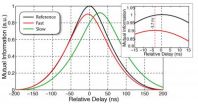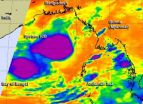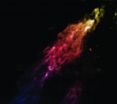(Press-News.org) Michael Lewis's bestselling book "Flash Boys" describes how some brokers, engaging in high frequency trading, exploit fast telecommunications to gain fraction-of-a-second advantage in the buying and selling of stocks. But you don't need to have billions of dollars riding on this-second securities transactions to appreciate the importance of fast signal processing. From internet to video streaming, we want things fast.
Paul Lett and his colleagues at the Joint Quantum Institute (1) specialize in producing modulated beams of light for encoding information. They haven't found a way to move data faster than c, the speed of light in a vacuum, but in a new experiment they have looked at how light traveling through so called "fast-light" materials does seem to advance faster than c, at least in one limited sense. They report their results (online as of 25 May 2014) in the journal Nature Photonics (2)
Seeing how light can be manipulated in this way requires a look at several key concepts, such as entanglement, mutual information, and anomalous dispersion. At the end we'll arrive at a forefront result.
CONTINUOUS VARIABLE ENTANGLEMENT
Much research at JQI is devoted to the processing of quantum information, information coded in the form of qubits. Qubits, in turn are tiny quantum systems---sometimes electrons trapped in a semiconductor, sometimes atoms or ions held in a trap---maintained in a superposition of states. The utility of qubits increases when two or more of them can be yoked into a larger quantum arrangement, a process called entanglement. Two entangled photons are not really sovereign particles but parts of a single quantum entity.
The basis of entanglement is often a discrete variable, such as electron spin (whose value can be up or down) or photon polarization (say, horizontal or vertical). The essence of entanglement is this: while the polarization of each photon is indeterminate until a measurement is made, once you measure the polarization of one of the pair of entangled photons, you automatically know the other photon's polarization too.
But the mode of entanglement can also be vested in a continuous variable. In Lett's lab, for instance, two whole light beams can be entangled. Here the operative variable is not polarization but phase (how far along in the cycle of the wave you are) or intensity (how many photons are in the beam). For a light beam, phase and intensity are not discrete (up or down) but continuous in variability.
QUANTUM MUTUAL INFORMATION
Biologists examining the un-seamed strands of DNA can (courtesy of the correlated nature of nucleic acid constituents) deduce the sequence of bases along one strand by examining the sequence of the other strand. So it is with entangled beams. A slight fluctuation of the instantaneous intensity of one beam (such fluctuations are inevitable because of the Heisenberg uncertainty principle) will be matched by a comparable fluctuation in the other beam.
Lett and his colleagues make entangled beams in a process called four-wave mixing. A laser beam (pump beam) enters a vapor-filled cell. Here two photons from the pump beam are converted into two daughter photons proceeding onwards with different energies and directions. These photons constitute beams in their own right, one called the probe beam, the other called the conjugate beam. Both of these beams are too weak to measure directly. Instead each beam enters a beam splitter (yellow disk in the drawing below) where its light can be combined with light from a local oscillator (which also serves as a phase reference). The ensuing interference patterns provide aggregate phase or intensity information for the two beams.
When the beam entanglement is perfect, the mutual correlation is 1. When studying the intensity fluctuations of one beam tells you nothing about those of the other beam, then the mutual correlation is 0.
FAST-LIGHT MATERIAL
In a famous experiment, Isaac Newton showed how incoming sunlight split apart into a spectrum of colors when it passed through a prism. The degree of wavelength-dependent dispersion for a material that causes this splitting of colors is referred to as its index of refraction.
In most materials the index is larger than 1. For plain window glass, it is about 1.4; for water it is 1.33 for visible light, and gradually increases as the frequency of the light goes up. At much higher frequency (equivalent to shorter wavelength), though, the index can change its value abruptly and go down. For glass, that occurs at ultraviolet wavelengths so you don't ordinarily see this "anomalous dispersion" effect. In a warm vapor of rubidium atoms, however, (and especially when modified with laser light) the effect can occur at infrared wavelengths, and here is where the JQI experiment looks.
In the figure above notice that the conjugate beam is sent through a second cell, filled with rubidium vapor. Here the beam is subject to dispersion. The JQI experiment aims to study how the entanglement of this conjugate beam with the probe beam (subject to no dispersion) holds up.
When the refraction is "normal"---that is, when index of refraction causes ordinary dispersion---the light signal is slowed in comparison with the beam which doesn't undergo dispersion. For this set of conditions, the cell is referred to as a "slow-light" material. When, however, the frequency is just right, the conjugate beam will undergo anomalous dispersion. When the different frequency components that constitute a pulse or intensity fluctuation reformulate themselves as they emerge from the cell, they will now be just slightly ahead of a pulse that hadn't gone through the cell. (To make a proper measurement of delay one needs two entangled beams---beams whose fluctuations are related.)
CAUSALITY
No, the JQI researchers are not saying that any information is traveling faster than c. The figure above shows that the peak for the mutual information for the fast-light-material is indeed ahead of the comparable peaks for an unscattered beam or for a beam emerging from a slow-light material. It turns out that the cost of achieving anomalous dispersion at all has been that additional gain (amplification) is needed, and this amplification imposes noise onto the signal.
This inherent limitation in extracting useful information from an incoming light beam is even more pronounced with beams containing (on average) one or less-than-one photon. Such dilute beams are desirable in many quantum experiments where measurement control or the storage or delay of quantum information is important.
"We did these experiments not to try to violate causality, said Paul Lett, "but because we wanted to see the fundamental way that quantum noise "enforces" causality, and working near the limits of quantum noise also lets us examine the somewhat surprising differences between slow and fast light materials when it comes to the transport of information."
INFORMATION:
(1) The Joint Quantum Institute is operated jointly by the National Institute of Standards and Technology in Gaithersburg, MD and the University of Maryland in College Park.
(2) "Quantum Mutual Information after One Half of an Entangled State Propagates through a Dispersive Medium," Jeremy B. Clark, Ryan T. Glasser, Quentin Glorieux, Ulrich Vogl, Tian Li, Kevin M. Jones, Paul D. Lett, Nature Photonics, published online 25 May 2014.
Paul Lett paul.lett@nist.gov (301) 975-6559
Ryan Glasser, ryan.glasser@gmail.com
Press contact at JQI: Phillip F. Schewe, pschewe@umd.edu, 301-405-0989. http://jqi.umd.edu/
Advanced light
Sending entangled beams through fast-light materials
2014-05-25
ELSE PRESS RELEASES FROM THIS DATE:
Sound and vision: Visual cortex processes auditory information too
2014-05-25
Scientists studying brain process involved in sight have found the visual cortex also uses information gleaned from the ears as well as the eyes when viewing the world.
They suggest this auditory input enables the visual system to predict incoming information and could confer a survival advantage.
Professor Lars Muckli, of the Institute of Neuroscience and Psychology at the University of Glasgow, who led the research, said: "Sounds create visual imagery, mental images, and automatic projections.
"So, for example, if you are in a street and you hear the sound of an ...
Brain imaging reveals clues about chronic fatigue syndrome
2014-05-24
A brain imaging study shows that patients with chronic fatigue syndrome may have reduced responses, compared with healthy controls, in a region of the brain connected with fatigue. The findings suggest that chronic fatigue syndrome is associated with changes in the brain involving brain circuits that regulate motor activity and motivation.
Compared with healthy controls, patients with chronic fatigue syndrome had less activation of the basal ganglia, as measured by fMRI (functional magnetic resonance imaging). This reduction of basal ganglia activity was also linked with ...
Slowing the insect invasion: Wood packaging sanitation yields US $11.7 billion net benefit
2014-05-24
The emerald ash borer (Agrilus plantipenis), a recent insect immigrant to North America carried in with the wooden packing material of imported goods, is projected to cause over a billion dollars in damages annually over the next decade. International standards now require expensive fumigation or heat treatment of wood pallets and crates to prevent the inadvertent import of new wood boring insect pests in shipping materials.
Preventative treatment is worthwhile when the cumulative damages of widening infestations are considered, report scientists in Ecological Society ...
Untangling whole genomes of individual species from a microbial mix
2014-05-23
BETHESDA, MD – May 23, 2014 – A new approach to studying microbes in the wild will allow scientists to sequence the genomes of individual species from complex mixtures. It marks a big advance for understanding the enormous diversity of microbial communities —including the human microbiome. The work is described in an article published May 22 in Early Online form in the journal G3: Genes|Genomes|Genetics, published by the Genetics Society of America.
"This new method will allow us to discover many currently unknown microbial species that can't be grown in the lab, while ...
Dawn breaks on Tropical Storm Amanda in Eastern Pacific
2014-05-23
Shortly after dawn broke in the Eastern Pacific Ocean this morning, May 23, Tropical Depression 1E organized and strengthened into the first tropical storm of the season: Amanda
NOAA's GOES-West satellite provided a visible image of Amanda on May 23 at 1500 UTC (11 a.m. EDT/8 a.m. PDT). The GOES imagery showed strong thunderstorms in the northern and western quadrants and is indicative of a better structure in the banding of thunderstorms around the low-level center of circulation.
By that time, Amanda's maximum sustained winds had increased to 40 mph (65 kph). Tropical-storm-force ...
Poor diet before pregnancy is linked with preterm birth
2014-05-23
University of Adelaide research has for the first time confirmed that women who eat a poor diet before they become pregnant are around 50% more likely to have a preterm birth than those on a healthy diet.
Researchers at the University of Adelaide's Robinson Research Institute investigated the dietary patterns of more than 300 South Australian women to better understand their eating habits before pregnancy.
It's the first study of its kind to assess women's diet prior to conception and its association with outcomes at birth.
The results, published in The Journal of ...
An infrared NASA eye sees a weaker System 92B
2014-05-23
System 92B appears to have weakened in the last day as an infrared look at the tropical low pressure area's cloud temperatures have shown. NASA's AIRS instrument is an infrared "eye in the sky" that recently flew over the weaker tropical low pressure area.
On May 22 at 19:29 UTC/3:29 p.m. EDT, NASA's Aqua satellite passed over System 92B and infrared data from the Atmospheric Infrared Sounder (AIRS) instrument and the SSMIS instrument saw patchy deep convection flaring and dissipating over the western portion of a low-level circulation center. Earlier on May 22, the areas ...
New drug for non-Hodgkin lymphoma and chronic lymphocytic leukemia passes early test
2014-05-23
A new chemotherapy drug being investigated for its potency against two types of cancer was found by scientists at Houston Methodist and seven other institutions to be effective in about one-third of the 58 patients who participated in a phase I study.
The drug, alisertib or MLN8237, inhibits the enzyme aurora A kinase, which is known to be very active during cell division. The present study, published in the journal Investigational New Drugs, looks at the safety, tolerability, and preliminary success of alisertib in treating non-Hodgkin lymphoma (NHL) and chronic lymphocytic ...
Wound-healing role for microRNAs in colon offer new insight to inflammatory bowel diseases
2014-05-23
DALLAS – May 23, 2014 – A microRNA cluster believed to be important for suppressing colon cancer has been found to play a critical role in wound healing in the intestine, UT Southwestern cancer researchers have found.
The findings, first discovered in mice and later reproduced in human cells, could provide a fresh avenue for investigating chronic digestive diseases and for potentially repairing damage in these and other disease or injury settings.
"We identified a novel role for microRNAs in regulating wound healing in the intestine. This finding has important ...
Failed dwarf galaxy survives galactic collision thanks to full dark-matter jacket
2014-05-23
Like a bullet wrapped in a full metal jacket, a high-velocity hydrogen cloud hurtling toward the Milky Way appears to be encased in a shell of dark matter, according to a new analysis of data from the National Science Foundation's Robert C. Byrd Green Bank Telescope (GBT). Astronomers believe that without this protective shell, the high-velocity cloud (HVC) known as the Smith Cloud would have disintegrated long ago when it first collided with the disk of our Galaxy.
If confirmed by further observations, a halo of dark matter could mean that the Smith Cloud is actually ...
LAST 30 PRESS RELEASES:
Low daily alcohol intake linked to 50% heightened mouth cancer risk in India
American Meteorological Society announces Rick Spinrad as 2026 President-Elect
Biomass-based carbon capture spotlighted in newly released global climate webinar recording
Illuminating invisible nano pollutants: advanced bioimaging tracks the full journey of emerging nanoscale contaminants in living systems
How does age affect recovery from spinal cord injury?
Novel AI tool offers prognosis for patients with head and neck cancer
Fathers’ microplastic exposure tied to their children’s metabolic problems
Research validates laboratory model for studying high-grade serous ovarian cancer
SIR 2026 delivers transformative breakthroughs in minimally invasive medicine to improve patient care
Stem Cell Reports most downloaded papers of 2025 highlight the breadth and impact of stem cell research
Oxford-led study estimates NHS spends around 3% of its primary and secondary care budget on the health impacts of heat and cold in England
A researcher’s long quest leads to a smart composite breakthrough
Urban wild bees act as “microbial sensors” of city health.
New study finds where you live affects recovery after a hip fracture
Forecasting the impact of fully automated vehicle adoption on US road traffic injuries
Alcohol-related hospitalizations from 2016 to 2022
Semaglutide and hospitalizations in patients with obesity and established cardiovascular disease
Researchers ‘listen in’ to embryo-mother interactions during implantation using a culture system replicating the womb lining
How changing your diet could help save the world
How to make AI truly scalable and reliable for real-time traffic assignment?
Beyond fragmented markets: A new framework for efficient and stable ride-pooling
Can shape priors make road perception more reliable for autonomous driving?
AI tracks nearly 100 years of aging research, revealing key trends and gaps
Innovative techniques enable Italy’s first imaging of individual trapped atoms
KIER successfully develops Korea-made “calibration thermoelectric module” for measuring thermoelectric device performance
Diversifying US Midwest farming for stability and resilience
Emphasizing immigrants’ deservingness shifts attitudes
Japanese eels, climate change, and river temperature
Pusan National University researchers discover faster, smarter heat treatment for lightweight magnesium metals
China’s 2024 Gastroenterology Report: marked progress in endoscopy quality and disease management
[Press-News.org] Advanced lightSending entangled beams through fast-light materials






